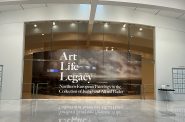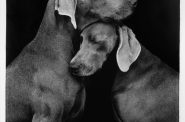Isaac Julien at MAM

Renowned filmmaker and video artist Isaac Julien was on hand to ensure the MAM Contemporary Gallery was playing “True North” as best possible. (Photos: Brian Jacobson)
London-based artist Isaac Julien is 4,000 miles from home, standing in a dark corner of the contemporary gallery of the Milwaukee Art Museum. Three screens show scenes of a black woman walking through forbidding landscapes in Iceland. The voices of Inuit throat singers swirl around Julien in 5.1 Surround Sound. Quotations from two famous explorers cut in, and then the consuming rush of an arctic waterfall.
It is the day before the opening of MAM’s Currents 34: Isaac Julien, which will showcase three of the installation artist and filmmaker’s Expedition films. Recently, the museum permanently acquired the final piece, Western Union: Small Boats (2007), for its collection and managed to get all three films for a year-long trilogy. The first two, True North (2004) and Fantôme Afrique (2005), run successively for two months each. The final piece goes on display June 28 through to Feb. 13, 2013.
Julien made sure that the three separate projectors playing True North were in rhythm with the sound, then talked with reporters about what this film meant to him and how the series ties together.
“What you’re hearing here is text from an autobiography of [black explorer] Matthew Henson, who accompanied Robert Peary on the expedition to the North Pole,” Julien explains. “It’s about an argument that took place between the two men. Henson believed he was in fact the first man to reach the pole before Peary, and consequently Peary kind of disowned him.”
Henson contended that he actually walked over the spot and planted the American flag. Peary had to finish the journey in a dog sled due to exhaustion. Without Henson’s guidance along with local Inuit guides, Peary would never have reached the top of the world. In the following years, Henson would be forgotten and become a file clerk for 30 years. Later, Congress would recognize Henson as an equal and award him the silver medal.
 Isaac Julien’s installation is a kind of reverie or poem, visual and aural, that re-traces the steps of the explorers. It plays into recurring themes in the artist’s filmography: feminism and Julien’s world view as a gay black man.
Isaac Julien’s installation is a kind of reverie or poem, visual and aural, that re-traces the steps of the explorers. It plays into recurring themes in the artist’s filmography: feminism and Julien’s world view as a gay black man.
“Part of the idea behind this work came from a book by Lisa Bloom, called Gender on Ice [American Ideologies of Polar Expeditions]‘,” says Julien. “It’s a fabulous book that talks about women explorers and ideas of masculinity and feminity, and questions around race. One chapter focuses on the texts of Matthew Henson, and so this [installation] is a meditation on both Henson’s words and also on expeditions. This was about the kind of polar, arctic sublime and how this area now is part of a lot of contestation regarding ecological aspects.”
In True North, actress Vanessa Myrie walks methodically into the distance of infinite horizon ice fields, then barefoot along a beach with crystal-clear melting glacier cubes, then in repose watching a dog sled team. In different tandem and separate frames, you see close-ups of Inuit faces along with waterfalls and a walkthrough of a chapel made of ice. During the 14-minute run, this memoir tests the boundaries of time and space as it trips dreamily along. You tend to forget where you are in this physical space, amid screens showing landscapes close to actual size. The screens complement one other; occasionally, they synchronize left to right to show one long panorama.
In Fantôme Afrique, Myrie returns as a kind of witness. It is set in West Africa, specifically Burkina Faso, considered the center of a Francophile-influenced film festival. Julien’s interest here was moving from the rural to the urban, from a wasteland to a place with unusual architecture, and a nod to surrealists like Michel Leiris and Andre Breton. Again it deals with disenfranchisement on a global scale, is shown on three screens, and features movement, shapes, and commentary.
The third and final work in the set, Western Union: Small Boats, will become part of the MAM collection. The last film is set in Sicily, and this time is a meditation on Visconti’s movie “The Leopard.” Julien considers it “a reverse expedition, it’s not Europeans coming to Africa, but in a way Africans coming to Europe in search of a better life.”
In the three-screen work, Libyans journey to Europe in modern times through the lens of Italian cinema. Again, Myrie appears as the trans-textural figure. Architecture, sculpture, and landscape serve as a cross-cultural language translator in the absence of dialogue. Julien is very interested in people moving from place to place around the world in present day. He portrays this by having actors moving through space, and this instance the emphasis is on the difficulty of the journey.
For more details on the trilogy and artist, visit the Milwaukee Art Museum website for hours and show information.
Art
-
Exhibit Tells Story of Vietnam War Resistors in the Military
 Mar 29th, 2024 by Bill Christofferson
Mar 29th, 2024 by Bill Christofferson
-
See Art Museum’s New Exhibit, ‘Portrait of the Collector’
 Sep 28th, 2023 by Sophie Bolich
Sep 28th, 2023 by Sophie Bolich
-
100 Years Of Memorable Photography
 Sep 18th, 2023 by Rose Balistreri
Sep 18th, 2023 by Rose Balistreri
















